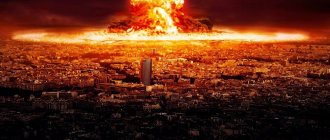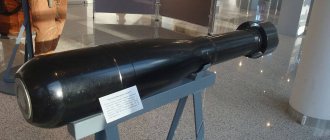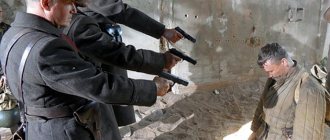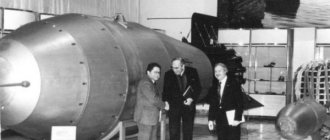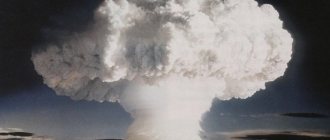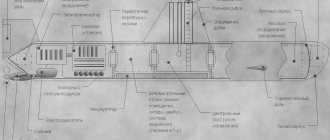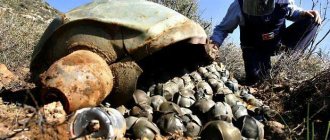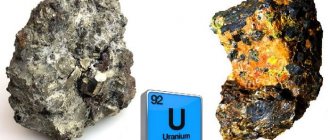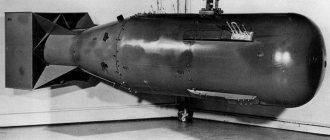The idea of thermonuclear weapons, where the nuclei of atoms are fused rather than split, as in an atomic bomb, appeared no later than 1941. It came to the minds of physicists Enrico Fermi and Edward Teller. Around the same time, they became involved in the Manhattan Project and helped create the bombs dropped on Hiroshima and Nagasaki. Designing a thermonuclear weapon turned out to be much more difficult.
You can roughly understand how much more complicated a thermonuclear bomb is than an atomic bomb by the fact that working nuclear power plants have long been commonplace, and working and practical thermonuclear power plants are still science fiction.
In order for atomic nuclei to fuse with each other, they must be heated to millions of degrees. The Americans patented a design for a device that would allow this to be done in 1946 (the project was unofficially called Super), but they remembered it only three years later, when the USSR successfully tested a nuclear bomb.
US President Harry Truman said that the Soviet breakthrough should be answered with “the so-called hydrogen, or superbomb.”
By 1951, the Americans assembled the device and conducted tests under the code name "George". The design was a torus—in other words, a donut—with heavy isotopes of hydrogen, deuterium and tritium. They were chosen because such nuclei are easier to merge than ordinary hydrogen nuclei. The fuse was a nuclear bomb. The explosion compressed deuterium and tritium, they merged, gave a stream of fast neutrons and ignited the uranium plate. In a conventional atomic bomb, it does not fission: there are only slow neutrons, which cannot cause a stable isotope of uranium to fission. Although nuclear fusion energy accounted for approximately 10% of the total energy of the George explosion, the “ignition” of uranium-238 allowed the explosion to be twice as powerful as usual, to 225 kilotons.
Photo: wikipedia.org
Due to the additional uranium, the explosion was twice as powerful as with a conventional atomic bomb. But thermonuclear fusion accounted for only 10% of the energy released: tests showed that hydrogen nuclei were not compressed strongly enough.
Then mathematician Stanislav Ulam proposed a different approach - a two-stage nuclear fuse. His idea was to place a plutonium rod in the “hydrogen” zone of the device. The explosion of the first fuse “ignited” the plutonium, two shock waves and two streams of X-rays collided - the pressure and temperature jumped enough for thermonuclear fusion to begin. The new device was tested on the Enewetak Atoll in the Pacific Ocean in 1952 - the explosive power of the bomb was already ten megatons of TNT.
Ivy Mike was the first atmospheric test of a hydrogen bomb conducted by the United States at Eniwetak Atoll on November 1, 1952. Photo: CTBTO
However, this device was also unsuitable for use as a military weapon.
For hydrogen nuclei to fuse, the distance between them must be minimal, so deuterium and tritium were cooled to a liquid state, almost to absolute zero. This required a huge cryogenic installation. The second thermonuclear device, essentially an enlarged version of the George, weighed 70 tons—you couldn’t drop that from an airplane.
Psychopathic genius
Edward Teller was not a moral man.
He despised and bullied his colleagues at the slightest opportunity - simply out of love for art and quarrelsomeness. Teller tried to deny Oppenheimer access to secret developments - what if he was secretly a communist sympathizer? The father of the American hydrogen bomb had the only love in his life. He loved atomic weapons very much, like the Sturmbannführer from Hellsing loved war. The bigger, more powerful and destructive - the better.
On the same topic
Dr. Strangelove, or "And the Authorities Are Hiding"
That's why Teller passionately hated the anti-war and anti-nuclear movement. He once blamed Jane Fonda for his heart attack because she called for caution with nuclear power after the accident at the Three Mile Island nuclear power plant.
Teller’s Soviet colleague, Academician Sakharov, also at first loved everything that coveted. He proposed creating thermonuclear tsunamis to wash away American cities - this is great physics! However, over time, Sakharov became horrified at the prospects of Armageddon and took the side of pacifism. And the tsunami plan, according to more rigorous calculations, turned out to be unworkable.
Teller, until his gray hair, was an ardent supporter of the full use of the atom, military and peaceful. Kubrick did not hide who inspired him to portray Dr. Strangelove. Only instead of a chair, the original had a prosthetic foot and did not yaw even involuntarily - this was not appropriate for a Hungarian Jew who despised the Nazis along with the communists.
Zamecki
For the sake of accuracy, Teller was not the only prototype of the Zigameth scientist.
Otherwise, the portrait of a psychopathic genius, a fanatic of nuclear war, turned out to be accurate.
Shock wave and thermal effect.
The direct (primary) impact of a superbomb explosion is threefold. The most obvious direct impact is a shock wave of enormous intensity. The strength of its impact, depending on the power of the bomb, the height of the explosion above the surface of the earth and the nature of the terrain, decreases with distance from the epicenter of the explosion. The thermal impact of an explosion is determined by the same factors, but also depends on the transparency of the air - fog sharply reduces the distance at which a thermal flash can cause serious burns.
According to calculations, during an explosion in the atmosphere of a 20-megaton bomb, people will remain alive in 50% of cases if they 1) take refuge in an underground reinforced concrete shelter at a distance of approximately 8 km from the epicenter of the explosion (E), 2) are in ordinary urban buildings at a distance of approx. . 15 km from EV, 3) found themselves in an open place at a distance of approx. 20 km from EV. In conditions of poor visibility and at a distance of at least 25 km, if the atmosphere is clear, for people in open areas, the likelihood of survival increases rapidly with distance from the epicenter; at a distance of 32 km its calculated value is more than 90%. The area over which the penetrating radiation generated during an explosion causes death is relatively small, even in the case of a high-power superbomb.
We need more bombs - and more bombs!
Teller was one of those who categorically insisted on the combat use of atomic weapons against the Japanese.
However, as the weapon became a reality, Teller lost interest in it. In the fall of 1941, Fermi voiced to him the idea of the Super project: what if deuterium was set on fire with a nuclear explosion and a much more powerful atomic fusion reaction was launched? Unlimitedly powerful in theory?
Teller was fascinated by the new prospect. Tens of kilotons is deadly boring and very small. A thermonuclear explosion can have a power of tens of megatons! Hundreds of megatons! And even more! This is really interesting.
Back in 1942, the scientist dumped the routine of Los Alamos on his assistants and focused on something more fun. For this he was quietly and sincerely thanked in Moscow. A significant part of Teller’s work on the atomic bomb had to be carried out by Klaus Fuchs, a talented British physicist and part-time ideological communist and agent of the NKGB of the USSR.
Zamecki
The name, as you can easily see, is not quite Yorkshire. The fact is that Fuchs was born in Germany and fled from the Nazis. After failure and a prison term, he returned to Germany - as expected, to the GDR.
Klaus Fuchs
When a nuclear explosion thundered over the Alamogordo test site for the first time in history, Teller violated the instructions and did not lie down. He remained standing and gazed in admiration at the flash and the billowing mushroom cloud.
“It was as if I had raised the curtains in a dark room and it was flooded with bright sunlight,” the scientist romantically described his impressions.
On the same topic
Save Hiroshima: a world without atomic bombs
Well, when some scientists tried to convince Washington to abandon the combat use of atomic bombs against Japan, Teller was adamant. He convinced Oppenheimer not to sign the petition, and he insisted on the bombing of Hiroshima and Nagasaki.
After much failure, Teller and his colleague Stanislaw Ulam proposed the design that now underlies all thermonuclear munitions. Their answer to the Sakharov puff was the Teller-Ulam sausage. The beauty was that it allowed an unlimited increase in the power of the explosion.
Teller was not invited to test his brainchild on the Enewetak Atoll - conflicts caused by his difficult character had an impact. On November 1, 1952, the scientist had to observe the explosion using a seismograph.
10.4 megatons, 450 Hiroshima. Teller could be pleased. But he wanted more.
Thermonuclear weapons
Modern thermonuclear weapons are strategic weapons that can be used by aviation to destroy the most important industrial and military facilities, and large cities as centers of civilization behind enemy lines. The most well-known type of thermonuclear weapon is thermonuclear (hydrogen) bombs, which can be delivered to the target by aircraft. Warheads of missiles for various purposes, including intercontinental ballistic missiles, can also be filled with thermonuclear charges. For the first time, such a missile was tested in the USSR back in 1957. Currently, the Strategic Missile Forces are armed with several types of missiles based on mobile launchers, silo launchers, and submarines.
Atomic bomb
The operation of thermonuclear weapons is based on the use of a thermonuclear reaction with hydrogen or its compounds. In these reactions, which occur at ultra-high temperatures and pressures, energy is released by the formation of helium nuclei from hydrogen nuclei, or from hydrogen and lithium nuclei. To form helium, mainly heavy hydrogen is used - deuterium, the nuclei of which have an unusual structure - one proton and one neutron. When deuterium is heated to temperatures of several tens of millions of degrees, its atom loses its electron shells during the first collisions with other atoms. As a result, the medium turns out to consist only of protons and electrons moving independently of them. The speed of thermal motion of particles reaches such values that deuterium nuclei can come closer and, thanks to the action of powerful nuclear forces, combine with each other, forming helium nuclei. The result of this process is the release of energy.
The basic diagram of a hydrogen bomb is as follows. Deuterium and tritium in a liquid state are placed in a tank with a heat-proof shell, which serves to preserve deuterium and tritium in a very cool state for a long time (to maintain it from a liquid state of aggregation). The heat-proof shell may contain 3 layers consisting of a hard alloy, solid carbon dioxide and liquid nitrogen. An atomic charge is placed near a reservoir of hydrogen isotopes. When an atomic charge is detonated, hydrogen isotopes are heated to high temperatures, creating conditions for a thermonuclear reaction to occur and a hydrogen bomb to explode. However, in the process of creating hydrogen bombs, it was found that it was impractical to use hydrogen isotopes, since in this case the bomb would acquire too much weight (more than 60 tons), which is why it was impossible to even think about using such charges on strategic bombers, and especially in ballistic missiles of any range. The second problem faced by the developers of the hydrogen bomb was the radioactivity of tritium, which made its long-term storage impossible.
Study 2 addressed the above issues. Liquid isotopes of hydrogen were replaced by the solid chemical compound of deuterium with lithium-6. This made it possible to significantly reduce the size and weight of the hydrogen bomb. In addition, lithium hydride was used instead of tritium, which made it possible to place thermonuclear charges on fighter bombers and ballistic missiles.
The creation of the hydrogen bomb did not mark the end of the development of thermonuclear weapons, more and more new samples appeared, the hydrogen-uranium bomb was created, as well as some of its varieties - heavy-duty and, conversely, small-caliber bombs. The last stage in the improvement of thermonuclear weapons was the creation of the so-called “clean” hydrogen bomb.
Doomsday Bomb
According to the recollections of colleagues, back in 1942, Teller was thinking about a thermonuclear superbomb with a yield of about 100 megatons. After the 15-megaton Castle Bravo explosion in March 1954 on the long-suffering Bikini Atoll, it became clear that US science and military industry had mastered heavy thermonuclear weapons.
On the same topic
A moment before the apocalypse: what happens inside a thermonuclear bomb
The general consensus was that the focus should now be on miniaturizing ammunition and precision delivery vehicles. Teller was not against it, but he also wanted to go beyond the “upper threshold.”
In the summer of 1954, Teller participated in a meeting of the General Advisory Committee of the US Atomic Energy Commission. He was angry. One of his devices did not work during the Castle tests, and a similar project was closed. A fresh idea was needed.
- Gentlemen, why not make a device with a capacity of ten gigatons? One such device could burn, say, California. Or Germany. Or Great Britain together with Ireland. Or both Koreas at once. Simple, fast, effective and convenient.
The nuclear weapons developers present were not the faint of heart, but Dr. Teller was quietly shocked by their proposal. Firstly, the radioactive contamination from such an explosion would be epoch-making. Secondly, the casualties of one strike will number in the tens of millions. Thirdly, the physics of such an explosion can present the darkest surprises.
Knowing the habits and methods of his colleague, his superiors wondered: had he secretly used the resources of the Livermore National Laboratory on this monster?
Dr. Israel Rabi, an old enemy of the inventor who tried with Fermi to prevent the development of US thermonuclear weapons, commented: “This is cheap PR, it should not be taken seriously.” Behind his back, he later added that “this world would be a better place without Teller.”
Teller in '54
Everyone present understood that it was technically possible to create a “country burner” with a capacity of 666 thousand Hiroshimas, counting it as 15 kilotons. The issue is resources and political will. Knowing Teller, one could be sure that he spoke completely seriously.
Even the most rabid hawks in Washington did not dare to think seriously about this. The achieved capacities were quite enough for them. Moreover, Stalin was dead, and the specter of preparations for the conquest of Eurasia that frightened the White House and the Pentagon was quickly dissipating.
Possible consequences of a hydrogen bomb explosion
First of all, the hydrogen bomb is a weapon of mass destruction. It can destroy not only with a blast wave, as TNT shells are capable of, but also with radiation consequences. What happens after the explosion of a thermonuclear charge:
- a shock wave that sweeps away everything in its path, leaving behind large-scale destruction;
- thermal effect - incredible thermal energy that can melt even concrete structures;
- radioactive fallout - a cloud mass with drops of radiation water, charge decay elements and radionuclides, moves with the wind and falls as precipitation at any distance from the epicenter of the explosion.
Near nuclear test sites or man-made disasters, a radioactive background has been observed for decades. The consequences of using a hydrogen bomb are very serious, capable of harming future generations.
Thanks to all!
A little history
After the world saw the destructive power of nuclear weapons, in August 1945, the USSR began a race that lasted until its collapse. The United States was the first to create, test and use nuclear weapons, the first to detonate a hydrogen bomb, but the USSR can be credited with the first production of a compact hydrogen bomb, which can be delivered to the enemy on a regular Tu-16. The first US bomb was the size of a three-story house; a hydrogen bomb of that size would be of little use. The Soviets received such weapons already in 1952, while the United States' first "adequate" bomb was adopted only in 1954. If you look back and analyze the explosions in Nagasaki and Hiroshima, you can come to the conclusion that they were not so powerful . Two bombs in total destroyed both cities and killed, according to various sources, up to 220,000 people. Carpet bombing of Tokyo could kill 150-200,000 people a day even without any nuclear weapons. This is due to the low power of the first bombs - only a few tens of kilotons in TNT equivalent. Hydrogen bombs were tested with an aim to overcome 1 megaton or more.
The first Soviet bomb was tested with a claim of 3 Mt, but in the end they tested 1.6 Mt.
A little history
Long-term contamination of the area with radioactive fallout.
In the event of hostilities, the use of a hydrogen bomb will lead to immediate radioactive contamination of an area within a radius of approx. 100 km from the epicenter of the explosion. If a superbomb explodes, an area of tens of thousands of square kilometers will be contaminated. Such a huge area of destruction with a single bomb makes it a completely new type of weapon. Even if the superbomb does not hit the target, i.e. will not hit the object with shock-thermal effects, the penetrating radiation and radioactive fallout accompanying the explosion will make the surrounding space uninhabitable. Such precipitation can continue for many days, weeks and even months. Depending on their quantity, the intensity of radiation can reach deadly levels. A relatively small number of superbombs is enough to completely cover a large country with a layer of radioactive dust that is deadly to all living things. Thus, the creation of the superbomb marked the beginning of an era when it became possible to make entire continents uninhabitable. Even long after the cessation of direct exposure to radioactive fallout, the danger due to the high radiotoxicity of isotopes such as strontium-90 will remain. With food grown on soils contaminated with this isotope, radioactivity will enter the human body.

